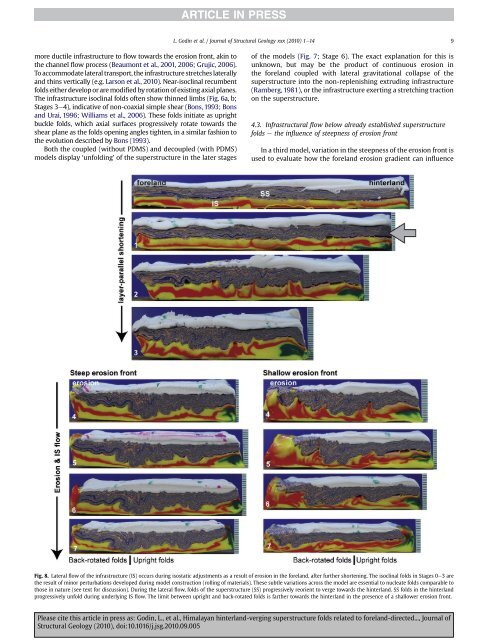8L. Godin et al. / Journal of Structural Geology xxx (2010) 1e14Fig. 7. Sequential pho<strong>to</strong>graphs of Model 50 (Stages 1e6), documenting infrastructural flow induced after layer-parallel shortening. The model was divided in two: one side withoutpolydimethylsiloxane (PDMS) at the infrastructure (IS)e<strong>superstructure</strong> (SS) contact (A), and the other side with a thin (w0.5 mm) layer of PDMS placed in the upper part of the IS <strong>to</strong>simulate the presence of leucogranites and migmatites in the upper part of the Greater <strong>Himalayan</strong> sequence (B). In Stages A1 and A2, the layer-parallel shortening is accommodatedby buckle <strong>folds</strong> in the SS and by active migration of IS material in cores of SS anticlines. In B1 and B2, the anticlinal cores are filled by PDMS, with minimal vertical IS migration. InSteps 3e6 in both A and B IS lateral flow, characterised by vertical thinning and horizontal stretching, is associated with isoclinal folding near the exhumation front. The geometry ofSS <strong>folds</strong> are modified by IS flow in A6, whereas there is a more efficient SS/IS decoupling visible in B5 and B6. The presence of PDMS favours more efficient decoupling between theSS and the IS, but inhibits geometrical modification of SS <strong>folds</strong> during subsequent IS lateral flow.4.2.1. Stages 1 and 2 e deformation during the shortening phaseDuring the first two stages of shortening, <strong>folds</strong> in the <strong>superstructure</strong>nucleate and propagate from the <strong>hinterland</strong> <strong>to</strong>wards theforeland (Fig. 7, Stages 1e2), comparable <strong>to</strong> the propagation of insequencethrusts predicted by critical taper (Davis et al., 1983). Theinitial phases of shortening produced upright open <strong>folds</strong> in the<strong>superstructure</strong> with a dominant wavelength of 8 mm. As shorteningprogresses, the initially open <strong>folds</strong> become progressively tighter butremain upright. The ductility of the detachment surface (presence orabsence of PDMS) has no apparent effect on fold style and developmentin the <strong>superstructure</strong> (Fig. 7; Stages 1e2). The absence ofthrusts in the model is likely due <strong>to</strong> the limitations of the materialsused but may also be the product of the initial coupling between the<strong>superstructure</strong> and the underlying material that inhibits thrusting(Bonini, 2007). Fold style in the <strong>superstructure</strong> is presumablycontrolled by internal viscosity contrasts, depending on the rheologyof the microlaminates, and coupling with the infrastructure.When strongly coupled <strong>to</strong> the <strong>superstructure</strong> (Fig. 7a), theinfrastructure developed upright <strong>to</strong> gently-inclined <strong>folds</strong> witha similar wavelength <strong>to</strong> <strong>folds</strong> in the overlying <strong>superstructure</strong>. These<strong>folds</strong> were most likely controlled by perturbations created at thebase of the overlying <strong>superstructure</strong>, such as in the core of antiforms,indicating that fold style in the ductile infrastructure wasmost likely controlled by <strong>folds</strong> in the more competent <strong>superstructure</strong>and not vice versa (Fig. 7a; Stages 1e2).When decoupled from the <strong>superstructure</strong> (Fig. 7b), the infrastructuredevelops broad open <strong>folds</strong>, which have a longer wavelengththan those in the <strong>superstructure</strong>. These <strong>folds</strong> becomeprogressively tighter as shortening continues. This suggests thatwhen coupled with the infrastructure, the <strong>superstructure</strong> controlsdeformation in the infrastructure and when decoupled, the infrastructuredeforms independently of the <strong>superstructure</strong> in the earlystages of shortening (Fig. 7b; Stages 1e2).4.2.2. Stages 3e6 e deformation during erosionThe style of deformation in the <strong>superstructure</strong> during erosionappears <strong>to</strong> be controlled by the proximity of the extruding channeland the ductility of the detachment. The most extreme change in<strong>superstructure</strong> fold geometry is found at the erosion front, proximal<strong>to</strong> the extruding infrastructure (Fig. 7a; Stages 5e6). When theductility contrast at the interface is small and significant <strong>superstructure</strong>-infrastructurecoupling exists, <strong>superstructure</strong> <strong>folds</strong> areprone <strong>to</strong> subsequent geometrical modification. When PDMS ispresent and the <strong>superstructure</strong>-infrastructure are effectivelydecoupled, modification of existing structures is slightly lessapparent, but still prominent. Upright <strong>folds</strong> in the <strong>superstructure</strong> arecommonly progressively modified in<strong>to</strong> inclined-<strong>to</strong>-the-<strong>hinterland</strong><strong>folds</strong> during lateral stretching of the infrastructure (Fig. 7a; Stage 6).Erosion in the model foreland decreases the vertical lithostatic load,which creates a lateral lithostatic pressure gradient that triggers thePlease cite this article in press as: Godin, L., et al., <strong>Himalayan</strong> <strong>hinterland</strong>-<strong>verging</strong> <strong>superstructure</strong> <strong>folds</strong> <strong>related</strong> <strong>to</strong> foreland-directed..., Journal ofStructural Geology (2010), doi:10.1016/j.jsg.2010.09.005
L. Godin et al. / Journal of Structural Geology xxx (2010) 1e14 9more ductile infrastructure <strong>to</strong> flow <strong>to</strong>wards the erosion front, akin <strong>to</strong>the channel flow process (Beaumont et al., 2001, 2006; Grujic, 2006).To accommodate lateral transport, the infrastructure stretches laterallyand thins vertically (e.g. Larson et al., 2010). Near-isoclinal recumbent<strong>folds</strong> either develop or are modified by rotation of existing axial planes.The infrastructure isoclinal <strong>folds</strong> often show thinned limbs (Fig. 6a, b;Stages 3e4), indicative of non-coaxial simple shear (Bons, 1993; Bonsand Urai, 1996; Williams et al., 2006). These <strong>folds</strong> initiate as uprightbuckle <strong>folds</strong>, which axial surfaces progressively rotate <strong>to</strong>wards theshear plane as the <strong>folds</strong> opening angles tighten, in a similar fashion <strong>to</strong>the evolution described by Bons (1993).Both the coupled (without PDMS) and decoupled (with PDMS)models display ‘unfolding’ of the <strong>superstructure</strong> in the later stagesof the models (Fig. 7; Stage 6). The exact explanation for this isunknown, but may be the product of continuous erosion inthe foreland coupled with lateral gravitational collapse of the<strong>superstructure</strong> in<strong>to</strong> the non-replenishing extruding infrastructure(Ramberg, 1981), or the infrastructure exerting a stretching tractionon the <strong>superstructure</strong>.4.3. Infrastructural flow below already established <strong>superstructure</strong><strong>folds</strong> e the influence of steepness of erosion frontIn a third model, variation in the steepness of the erosion front isused <strong>to</strong> evaluate how the foreland erosion gradient can influenceFig. 8. Lateral flow of the infrastructure (IS) occurs during isostatic adjustments as a result of erosion in the foreland, after further shortening. The isoclinal <strong>folds</strong> in Stages 0e3 arethe result of minor perturbations developed during model construction (rolling of materials). These subtle variations across the model are essential <strong>to</strong> nucleate <strong>folds</strong> comparable <strong>to</strong>those in nature (see text for discussion). During the lateral flow, <strong>folds</strong> of the <strong>superstructure</strong> (SS) progressively reorient <strong>to</strong> verge <strong>to</strong>wards the <strong>hinterland</strong>. SS <strong>folds</strong> in the <strong>hinterland</strong>progressively unfold during underlying IS flow. The limit between upright and back-rotated <strong>folds</strong> is farther <strong>to</strong>wards the <strong>hinterland</strong> in the presence of a shallower erosion front.Please cite this article in press as: Godin, L., et al., <strong>Himalayan</strong> <strong>hinterland</strong>-<strong>verging</strong> <strong>superstructure</strong> <strong>folds</strong> <strong>related</strong> <strong>to</strong> foreland-directed..., Journal ofStructural Geology (2010), doi:10.1016/j.jsg.2010.09.005
















